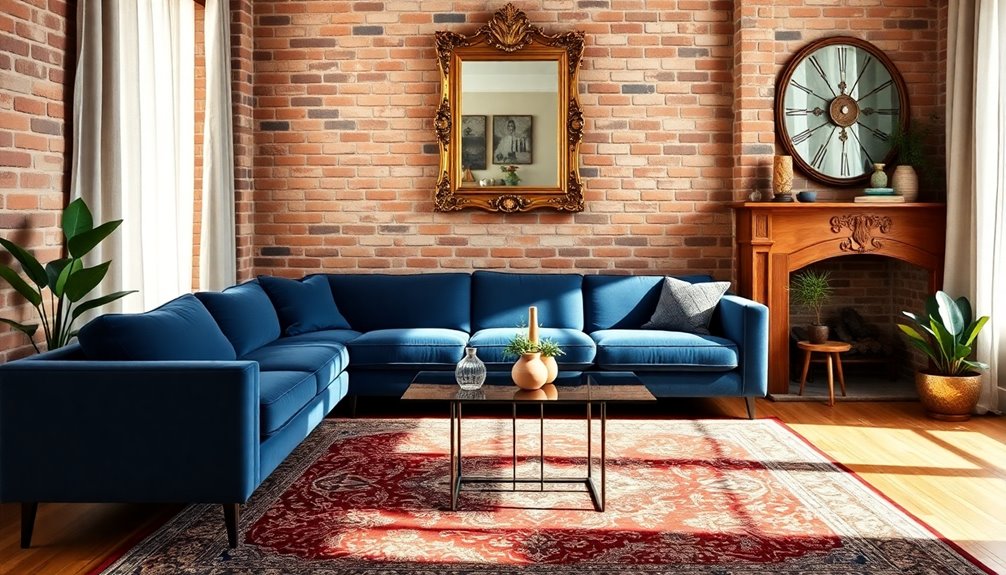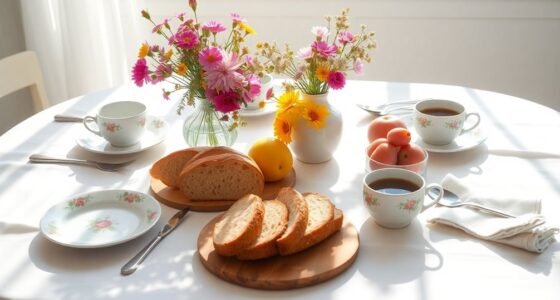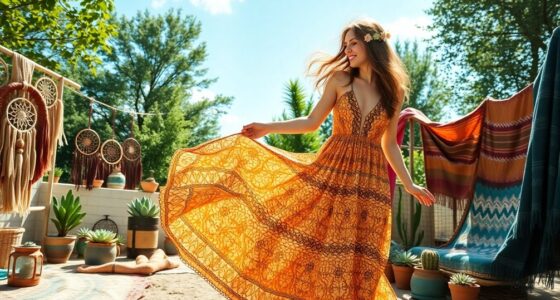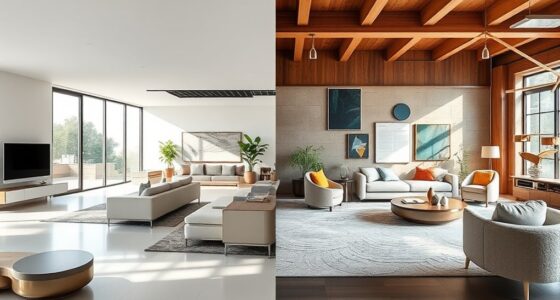Mixing modern and traditional decor can create a stunning blend that reflects your personal style. Start by choosing a consistent color palette to unify diverse pieces. Incorporate traditional elements like ornate rugs with contemporary furniture for added depth. Balance is key, so pair minimalist tables with vintage decor to create visual interest. Look for unique pieces at flea markets or online platforms to enhance your collection. Layer textures and strategically place decor items to maintain harmony. By considering these tips, you'll set the groundwork for a beautifully eclectic space where both styles shine together. There's plenty more to explore!
Key Takeaways
- Use a consistent color palette to unify diverse modern and traditional pieces for a harmonious look.
- Incorporate traditional elements like ornate rugs or architectural details alongside modern furniture for added depth.
- Create a focal point with abstract art or modern lighting to draw attention and balance the design.
- Pair different textures, such as minimalist tables with traditional fabrics, to enhance visual interest and cohesion.
- Disperse vintage items throughout the space to maintain a unified design without overcrowding.
Understanding Furniture Styles
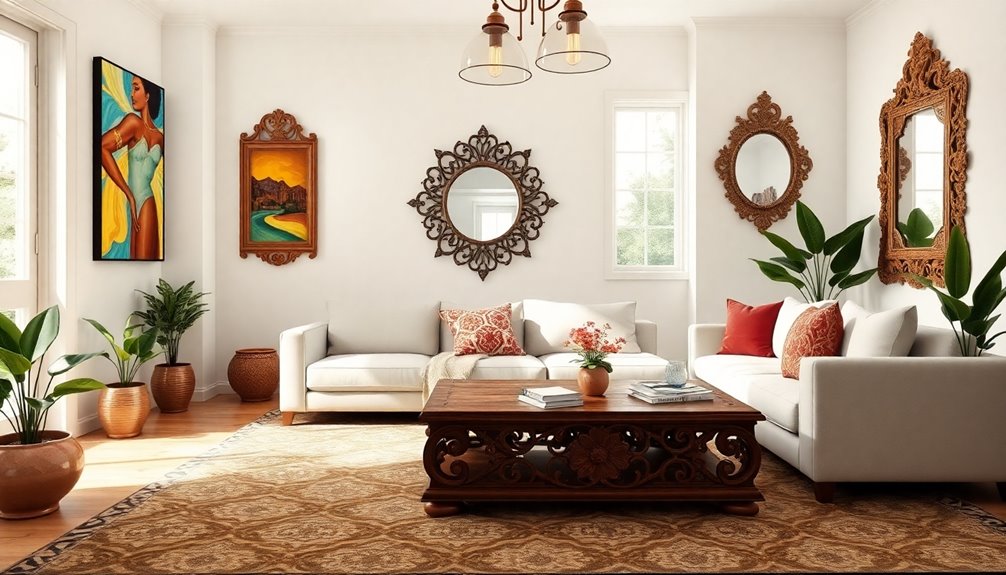
When it comes to decorating your home, understanding furniture styles is essential for achieving a cohesive look.
You'll want to recognize the differences between modern and traditional designs. Modern furniture, emerging from the 1940s, emphasizes simplicity and functionality, featuring iconic styles like Bauhaus.
In contrast, traditional furniture showcases intricate details and historical continuity, with pieces like Chippendale and Lawson sofas.
Mixing these styles can lead to a unique decor, but it's crucial to also grasp transitional furniture, which blends contemporary and traditional elements for a versatile aesthetic.
Key Elements for Mixing
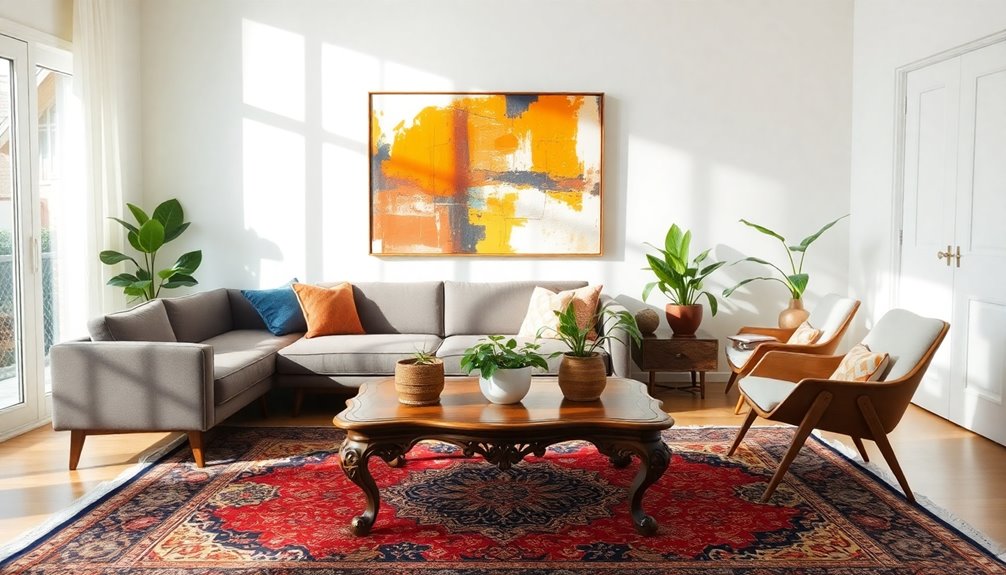
Mixing modern and traditional decor can create a dynamic and inviting space that showcases your unique style.
To effectively mix traditional and modern elements, start by selecting a consistent color palette that ties everything together. This way, even eclectic pieces can complement each other rather than clash.
Incorporate traditional elements like ornate architecture or rugs alongside modern furniture, such as minimalist coffee tables, to add depth and textures.
You can also introduce a focal point, like a piece of abstract art or modern lighting, to draw the eye and balance the design.
Remember to maintain harmony by leaning toward one style, ensuring the space feels cohesive and visually appealing. Additionally, incorporating unique textures can further enhance the overall aesthetics of your mixed decor.
With these key elements, you'll create a unique atmosphere that reflects your personality.
Sourcing Unique Furniture Pieces
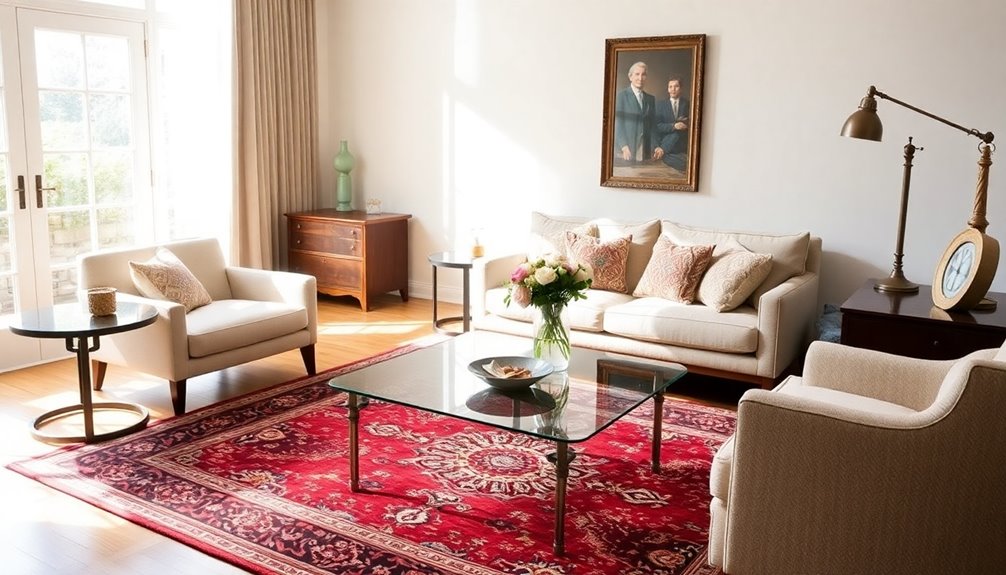
To create a truly personalized space, you'll want to seek out unique furniture pieces that reflect your style and add character to your decor.
Start sourcing unique furniture pieces from platforms like Facebook Marketplace and Vinterior, where you can find local treasures and curated vintage selections.
Flea markets and charity shops are perfect for discovering affordable vintage finds that enable you to mix and match traditional and modern styles.
Don't overlook online classifieds like eBay and Gumtree for second-hand furniture that suits your budget.
You might even find free items on platforms like Freegle or from curbside finds.
Just remember to focus on practical and kid-friendly pieces, ensuring your selections are both stylish and functional. Additionally, consider incorporating wall organization systems that can create visual interest and functionality in your mixed decor.
Achieving Balance in Design
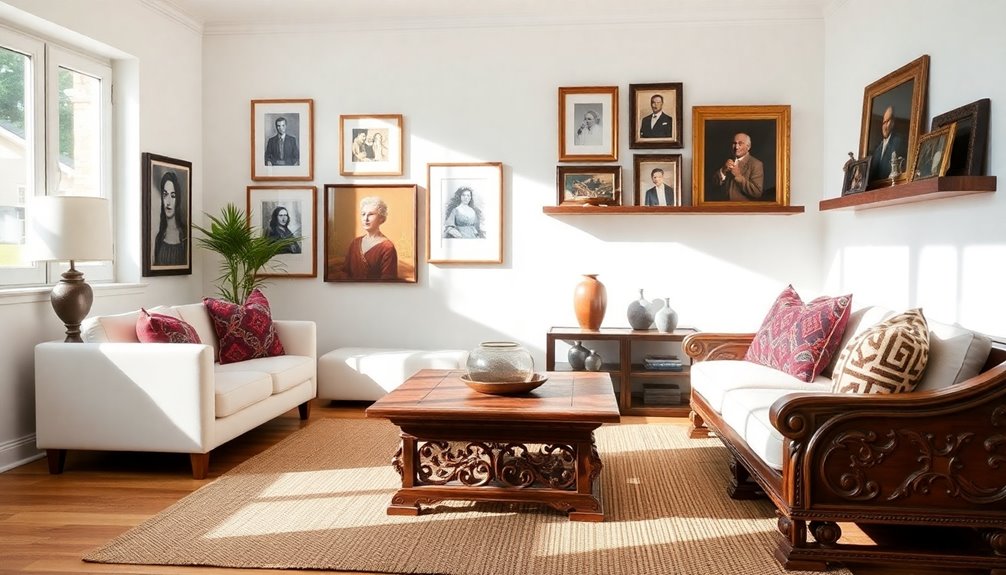
Achieving balance in design is essential for creating a harmonious space that feels both inviting and stylish.
When mixing traditional and modern decor, focus on pairing textures, like modern minimalist tables with traditional rugs, to create visual interest. To achieve balance, avoid overcrowding your space with too many vintage items; instead, place a few strategically alongside contemporary pieces.
Using color blocking can enhance the juxtaposition of styles, allowing for a cohesive aesthetic. Disperse vintage elements throughout your space rather than clustering them to ensure a unified design.
Balancing proportions is crucial too; for instance, pairing large, ornate antiques with minimalistic contemporary furniture can create a visually appealing contrast, enhancing the room's character and overall harmonious look. Additionally, incorporating farmhouse-style lighting fixtures can elevate the atmosphere and tie together both modern and traditional elements effectively.
Unifying Modern and Traditional

While creating a space that seamlessly blends modern and traditional decor, it's essential to establish a unifying theme that ties the elements together.
Start by sticking to a consistent color palette that incorporates both styles, ensuring harmony throughout the room. Pair traditional pieces, like a classic armchair, with modern shapes, such as a sleek coffee table, to achieve balance.
Use bold statement pieces, like oversized modern artwork, to create a visual focal point that unifies diverse elements. To maintain cohesion, select eclectic items that share similar textures or materials.
Finally, disperse vintage elements throughout the space instead of clustering them, allowing for a smooth flow while integrating modern and traditional decor. This approach helps create a harmonious blend that feels intentional. Additionally, consider incorporating cultural motifs that reflect your heritage, enhancing the connection between the two styles.
Adding Finishing Touches
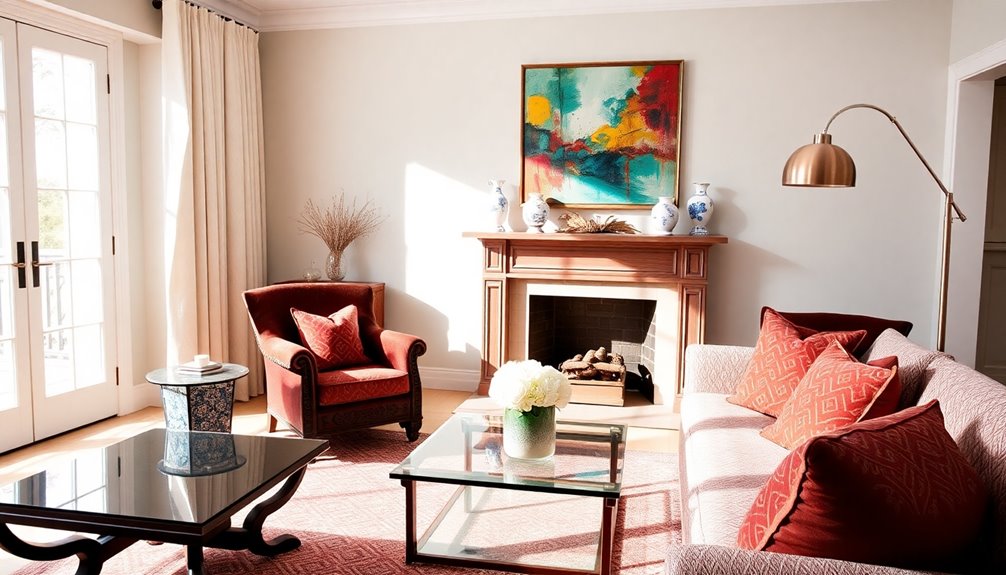
Finishing touches are crucial for creating a well-rounded space that harmoniously blends modern and traditional decor.
Start by incorporating art pieces that reflect both styles, like contemporary paintings in vintage frames, to create a cohesive visual narrative.
Use textiles, such as velvet throw pillows and modern blankets, to add warmth and comfort, bridging the gap between traditional and modern pieces.
Introduce plants and greenery to soften the overall look, complementing both minimalist designs and ornate furnishings.
Consider statement lighting, like a modern chandelier or vintage lamp, to serve as a focal point.
Finally, layer decorative accessories, mixing antique vases with modern sculptures, to inject personality and depth while ensuring each piece enhances the overall aesthetic without overwhelming the space. Additionally, incorporating farmhouse textiles can enhance the cozy feel, blending seamlessly with both modern and traditional elements.
Seasonal Trends in Decor

Blending modern and traditional decor sets a solid foundation for embracing seasonal trends.
You'll find that autumn invites warm, earthy colors and natural materials like wood and stone, creating a cozy atmosphere with traditional pieces.
As spring and summer roll in, switch to lighter colors and breathable fabrics like linen and cotton, reflecting nature's vibrant energy.
The art of mixing textures is key; incorporate cozy velvet throws in colder months and airy cotton cushions in warmer ones.
Seasonal trends in decor also encourage adding themed artwork and greenery, keeping your space fresh without a complete overhaul.
Don't forget to take advantage of seasonal sales to experiment with new colors and materials, making updates affordable and fun! Additionally, incorporating natural elements from your surroundings can enhance tranquility and create a more harmonious environment.
Frequently Asked Questions
How to Mix Traditional and Modern Interior Design?
To mix traditional and modern interior design, start by choosing a dominant style, using the 80/20 rule.
Incorporate essential traditional pieces, like a classic sofa, then add modern accents, such as sleek lighting or artwork.
Use a consistent color palette to create harmony, and don't hesitate to experiment with textures and shapes.
Embrace your creativity; the goal is to make your space uniquely yours while balancing the classic and contemporary elements effectively.
Can You Mix Traditional and Modern Art?
Mixing traditional and modern art can feel like blending a classic novel with a contemporary poem; both tell stories, but in different styles.
You can absolutely showcase both in your space! Use oversized modern pieces as focal points, placing them alongside traditional art to create a dialogue.
Stick to a consistent color palette and consider minimalist frames for your traditional pieces. This way, both styles can shine without competing for attention.
What Is the 70/30 Rule in Interior Design?
The 70/30 rule in interior design suggests you should use 70% of one dominant style and 30% of a complementary style in your space.
By doing this, you create a balanced and visually engaging room. Focus on larger furniture pieces for the 70% and incorporate smaller decor items for the 30%.
This approach keeps your space cohesive and prevents it from feeling cluttered, allowing for personal expression while maintaining design integrity.
Is It Okay to Mix Traditional and Modern Furniture?
Yes, it's absolutely okay to mix traditional and modern furniture.
Doing so can create a unique space that reflects your personal style. Just aim for a balance, like using mostly one style with a few pieces from the other.
Incorporate a consistent color palette and complementary textures to tie everything together.
Don’t forget to find a focal point that unifies the decor, making your space feel cohesive and inviting. Incorporating unique elements that reflect your style can further enhance this focal point. Consider blending modern pieces with some ancient Egyptian decor ideas that add an exotic allure and history to your space. Artifacts, symbols, and colors inspired by this rich culture can create a captivating backdrop that draws attention and sparks conversation among your guests.
Conclusion
Mixing modern and traditional decor is like weaving a tapestry, where each thread tells its own story yet contributes to a greater picture. By carefully selecting your furniture and balancing elements, you create a space that feels both timeless and fresh. This harmonious blend reflects your unique journey, inviting warmth and nostalgia alongside contemporary flair. So go ahead, embrace the contrasts, and let your home become a canvas where the past and present dance together in perfect unity.
